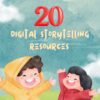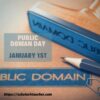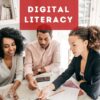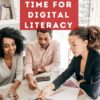
Category: Digital Literacy
How to use Digital Quick Writes–the video
How to use Digital Quick Writes
This video is from a series I taught for school districts. It is now available for free, here on Ask a Tech Teacher:
–summarized by NoteGPT
Summary
In this video, Jacqui Murray discusses the concept of “quick writes” as a dynamic and engaging way to teach writing in the classroom. Quick writes are short, spontaneous writing exercises that allow students to express their thoughts and ideas without the pressure of formal writing tasks. Murray emphasizes the importance of variety and choice in writing activities, which can cater to students’ different preferences and skills. By integrating technology and allowing students to use a range of mediums—such as audio, visual, and written forms—quick writes not only reinforce writing skills but also enhance problem-solving, creative thinking, and communication abilities. The video outlines practical strategies for implementing quick writes in the classroom, provides examples of tools and techniques, and highlights how these exercises can meet Common Core standards. Overall, Murray advocates for a process-oriented approach to writing, focusing on student engagement and skill development rather than the final product.
Highlights
- ✍️ Dynamic Writing Experience: Quick writes offer an engaging alternative to traditional writing assignments, allowing students to express themselves freely.
- 🌍 Integration of Technology: Incorporating various digital tools enhances the writing experience and fosters creativity among students.
- 🎨 Variety of Mediums: Students can choose from multiple formats—writing, drawing, audio—to communicate their ideas effectively.
- 🕒 Short and Focused: Quick writes typically last 10-15 minutes, encouraging concise and thoughtful expression of ideas.
- 📢 Process Over Product: The focus is on the writing process and student effort rather than the final outcome, promoting a growth mindset.
- 📚 Alignment with Common Core: Quick writes can be tailored to meet various educational standards, making them versatile across subjects.
- 🤝 Collaborative Learning: Sharing and discussing quick writes with peers enhances understanding and communication skills.
Key Insights
- 📅 Flexibility in Timing: Quick writes can be integrated into any part of a lesson, making them adaptable to various subjects and topics. This flexibility allows teachers to connect writing with ongoing projects or discussions, reinforcing the relevance of writing in different contexts.
- 💡 Choice Empowers Students: By providing students with options for how they want to express their ideas—be it through writing, drawing, or using multimedia—teachers can cater to diverse learning styles. This choice not only fosters engagement but also encourages students to take ownership of their learning process.
- 🛠️ Technological Proficiency: Incorporating digital tools and platforms into quick writes helps students become more comfortable with technology. This not only prepares them for future academic challenges but also equips them with essential skills for the modern workforce.
- 🎯 Focus on Skill Development: Quick writes emphasize the importance of developing writing skills through practice rather than perfection. By creating a low-stakes environment where effort and process are prioritized, students are more likely to take risks and experiment with their writing.
- 🤔 Critical Thinking and Problem Solving: Engaging in quick writes requires students to think critically and solve problems quickly, especially when using new technologies or formats. This process aligns with educational standards that emphasize critical thinking as a vital skill for success.
- 📝 Assessment for Learning: Instead of grading the final product, teachers assess students based on their effort and engagement during quick writes. This formative assessment approach allows for ongoing feedback and supports a learning environment focused on growth rather than competition.
- 🎉 Fun and Engagement: Quick writes can be a fun way to break up traditional lessons, making writing enjoyable for students who may otherwise find it daunting. By incorporating games and creative formats, teachers can foster a love for writing that extends beyond the classroom.
Conclusion
Jacqui Murray’s discussion on quick writes highlights the importance of innovative and flexible writing practices in education. By integrating technology, allowing for student choice, and emphasizing the writing process, educators can create a more engaging and effective writing experience. Quick writes serve as a powerful tool to develop not only writing skills but also critical thinking, problem-solving, and collaboration—all of which are essential for students in today’s world. Through this approach, teachers can foster a classroom environment that values creativity, encourages exploration, and supports skill development for all learners.
Share this:
- Click to share on Facebook (Opens in new window) Facebook
- Click to share on X (Opens in new window) X
- Click to share on LinkedIn (Opens in new window) LinkedIn
- Click to share on Pinterest (Opens in new window) Pinterest
- Click to share on Telegram (Opens in new window) Telegram
- Click to email a link to a friend (Opens in new window) Email
- More
18 Digital Tool Musts in the Classroom — a Video
18 Digital Tool Musts in the Classroom
This video is from a series I taught for school districts. It is now available for free, here on Ask a Tech Teacher:
Summary
18 essential digital tools for classrooms, emphasizing their impact on modern education.
Highlights
- ✏️ Annotation Tools: Essential for digital note-taking.
- 👤 Avatars: Promote digital citizenship and privacy.
- 💬 Backchannel Devices: Enhance classroom communication.
- 🗓️ Class Calendars: Keep students organized and informed.
- 🌐 Class Websites: Centralize classroom resources and communication.
- 📚 Digital Portfolios: Collect and showcase student work.
- 📊 Online Quizzes: Provide fun and quick assessments.
Key Insights
- 📝 Annotation tools like Notability and Adobe Acrobat empower students to engage with digital texts actively, fostering comprehension and retention.
- 🎨 Using avatars instead of personal images encourages student privacy and encourages creativity in digital representation, reinforcing digital citizenship principles.
- 🌍 Backchannel communication tools like Padlet and Twitter create a collaborative classroom environment where students can ask questions and share ideas in real time.
- 📅 Integrating class calendars keeps students accountable and involved in managing their schedules, enhancing organizational skills from an early age.
- 🖥️ Class websites serve as a hub for resources, helping parents and students stay connected and informed about class activities and expectations.
- 📂 Digital portfolios allow students to curate their work, promoting self-reflection and ownership of their learning journey while simplifying the grading process for teachers.
- 🎉 Online quizzes not only engage students but also provide instant feedback, enabling educators to identify learning gaps and adjust instruction accordingly.
–summarized by NoteGPT
This video is from a series I taught for school districts. It is now available for free to Ask a Tech Teacher subscribers. Videos include (in alphabetic order):
- 15 Webtools in 15 Weeks
- 18 Digital Tools in the Classroom
- A focus on strategies
- Alternative tools
- Assessment isn’t static
- Author doers
- BYOD
- Class warm-ups
- Collaboration
- Curriuculum Maps
- Differentiation–How to teach the hard-to-teach class
- Digital Citizenship: What to Teach When
- Flipping the classroom
- Gamification of education
- How to Teach a Tech Lesson
- Presentation Boards
- Tech-infused classroom
- Tech tools
- The 20% rule
- Using backchannel devices
- Warm-ups
Here’s the sign-up link if the image above doesn’t work:
https://forms.aweber.com/form/07/1910174607.htm
“The content presented in this blog are the result of creative imagination and not intended for use, reproduction, or incorporation into any artificial intelligence training or machine learning systems without prior written consent from the author.”
Jacqui Murray has been teaching K-18 technology for 30 years. She is the editor/author of over a hundred tech ed resources including a K-12 technology curriculum, K-8 keyboard curriculum, K-8 Digital Citizenship curriculum. She is an adjunct professor in tech ed, Master Teacher, webmaster for four blogs, freelance journalist on tech ed topics, contributor to NEA Today, and author of the tech thrillers, To Hunt a Sub and Twenty-four Days. You can find her resources at Structured Learning.
Share this:
- Click to share on Facebook (Opens in new window) Facebook
- Click to share on X (Opens in new window) X
- Click to share on LinkedIn (Opens in new window) LinkedIn
- Click to share on Pinterest (Opens in new window) Pinterest
- Click to share on Telegram (Opens in new window) Telegram
- Click to email a link to a friend (Opens in new window) Email
- More
20 Online Resources About Digital Storytelling
Digital storytelling is a modern form of storytelling that uses digital tools and multimedia elements to craft and convey narratives. It blends traditional storytelling with digital technologies, allowing stories to be told through various digital formats, including videos, podcasts, blogs, social media, interactive websites, and multimedia presentations.
Here are popular online resources to teach about digital storytelling (click here for updates to list):
- Adobe Creative Cloud Express–digital stories that blend images and audio into a video
- Adobe Voice–Show your story; free
- Bluster–word matching game develops vocabulary and word understanding for school-aged children (app)
- Book Creator
- Book Writer--write books on an iPad; view in iBooks (fee) (app)
- Comic Book!(app)
- Create a story
- Draw a Stickman–draw the main character of your story; the site turns it into a choose-your-own-adventure story, asking you to add detail. (app)
- Newspapers, posters, comics—learn to create
- Pixton–use their storytelling layout (picture at top, text at bottom)
- Puppet Pals – Create simple animated stories with puppets and even yourself!
- Shutterfly Photostory–self-published student books (app)
- StoryBird—-storytelling with art–beautiful
- Storyboard That–use their storytelling layout (picture at top, text at bottom)
- StoryJumper–build a book
- Sutori–use a variety of multimedia; fee/free accounts
- VoiceThread (app)
- Write About This–writing prompts for students (app)
Lesson Plans
Here’s the sign-up link if the image above doesn’t work:
https://forms.aweber.com/form/07/1910174607.htm
“The content presented in this blog are the result of creative imagination and not intended for use, reproduction, or incorporation into any artificial intelligence training or machine learning systems without prior written consent from the author.”
Jacqui Murray has been teaching K-18 technology for 30 years. She is the editor/author of over a hundred tech ed resources including a K-12 technology curriculum, K-8 keyboard curriculum, K-8 Digital Citizenship curriculum. She is an adjunct professor in tech ed, Master Teacher, webmaster for four blogs, freelance journalist on tech ed topics, contributor to NEA Today, and author of the tech thrillers, To Hunt a Sub and Twenty-four Days. You can find her resources at Structured Learning.
Share this:
- Click to share on Facebook (Opens in new window) Facebook
- Click to share on X (Opens in new window) X
- Click to share on LinkedIn (Opens in new window) LinkedIn
- Click to share on Pinterest (Opens in new window) Pinterest
- Click to share on Telegram (Opens in new window) Telegram
- Click to email a link to a friend (Opens in new window) Email
- More
May the 4th Be With You
[caption id="attachment_67306" align="aligncenter" width="628"] credit: https://transgriot.blogspot.com/[/caption]
credit: https://transgriot.blogspot.com/[/caption]
 credit: https://transgriot.blogspot.com/[/caption]
credit: https://transgriot.blogspot.com/[/caption]
Share this:
- Click to share on Facebook (Opens in new window) Facebook
- Click to share on X (Opens in new window) X
- Click to share on LinkedIn (Opens in new window) LinkedIn
- Click to share on Pinterest (Opens in new window) Pinterest
- Click to share on Telegram (Opens in new window) Telegram
- Click to email a link to a friend (Opens in new window) Email
- More
Public Domain Day and Happy New Year!
Every year, January 1st is Public Domain Day. This is an observance of when copyrights expire and works enter into the public domain–free for all to use. According to Public Domain Review, here are some of the newly-available artistic works you might like a/o January 1, 2023:
The picture above is interactive. If you click it, you enter Public Domain Review’s website and can then explore each of these new sources of inspiration, free to use.
One that caught my attention is Winnie the Pooh, now in the public domain. Knowing that, I should feel comfortable posting his picture: (more…)
Share this:
- Click to share on Facebook (Opens in new window) Facebook
- Click to share on X (Opens in new window) X
- Click to share on LinkedIn (Opens in new window) LinkedIn
- Click to share on Pinterest (Opens in new window) Pinterest
- Click to share on Telegram (Opens in new window) Telegram
- Click to email a link to a friend (Opens in new window) Email
- More
Coding and US Security
If you’re a history teacher, here’s a reprint of an article I wrote a few years ago. It’s a great tie-in to Hour of Code:
During WWI, the Choctaw language had been used to transmit U.S. military messages. With this thought in mind, Philip Johnston, the son of a missionary grew up on a Navajo reservation and spoke the Diné tongue fluently, brought the suggestion of a similar code to General Clayton Vogel early in 1942. The Diné language has no alphabet, uses no symbols and one sound may hold an entire concept. The idea was tested and proved to be faster and more reliable than the mechanized methods. The language has more verbs than nouns, that helps to move the sentences along and makes it far more difficult for outsiders to learn – making it the most ingenious and successful code in military history.
Share this:
- Click to share on Facebook (Opens in new window) Facebook
- Click to share on X (Opens in new window) X
- Click to share on LinkedIn (Opens in new window) LinkedIn
- Click to share on Pinterest (Opens in new window) Pinterest
- Click to share on Telegram (Opens in new window) Telegram
- Click to email a link to a friend (Opens in new window) Email
- More
Tech Tip #169: What is Digital Literacy?
 In these 169 tech-centric situations, you get an overview of pedagogy—the tech topics most important to your teaching—as well as practical strategies to address most classroom tech situations, how to scaffold these to learning, and where they provide the subtext to daily tech-infused education.
In these 169 tech-centric situations, you get an overview of pedagogy—the tech topics most important to your teaching—as well as practical strategies to address most classroom tech situations, how to scaffold these to learning, and where they provide the subtext to daily tech-infused education.
Today’s tip: What is Digital Literacy?
Category: Pedagogy
‘Digital literacy’ is one of those buzz words floated by experts as being granular to 21st-century students. It’s everywhere, on everyone’s tongue, but figuring out what it means can be daunting. ‘Literacy’ is simple: the ability to read and write–so ‘digital literacy’ should be achieving those goals digitally.
Sounds simple. The difficult is in the implementation. Here are the sixteen transformative tools, activities, and/or knowledge bases digitally-literate students should be comfortable using:
- annotation tool
- backchannel device
- class internet start page
- class website or blog
- cloud computing
- digital citizenship
- digital class calendar
- digital databases
- digital devices–such as laptops, iPads, Chromebooks, or desktops, for daily use
- online information
- sharing digitally to build knowledge
- social media
- student digital portfolios–to curate and collect work
- email–or another method of communicating quickly outside classtime (such as messaging or Twitter)
- virtual collaboration
- vocabulary tool–to quickly decode words students don’t understand
For more detail on the tools, activities, and knowledge bases above—as well as the general topic of digital literacy—visit “Digital Literacy—What is it?” on Ask a Tech Teacher.
More on Digital Literacy:
- How to Assess Digital Literacy
- Digital Literacy in Busy Classrooms
- Digital Literacy–Too Important to Skip
Sign up for a new tip each week or buy the entire 169 Real-world Ways to Put Tech into Your Classroom.
What’s your favorite tech tip in your classroom? Share it in the comments below.
Copyright ©2022 worddreams.wordpress.com – All rights reserved.
Share this:
- Click to share on Facebook (Opens in new window) Facebook
- Click to share on X (Opens in new window) X
- Click to share on LinkedIn (Opens in new window) LinkedIn
- Click to share on Pinterest (Opens in new window) Pinterest
- Click to share on Telegram (Opens in new window) Telegram
- Click to email a link to a friend (Opens in new window) Email
- More
Digital Literacy in Busy Classrooms
This is a common complaint in my grad school classes. Yes, teachers know students don’t have all of the skills they need for the technology required in education, but who has time to teach it? Newsweek has an interesting article addressing exactly that:
How Schools Can Find the Time To Teach Digital Literacy Skills
According to the U.S. Bureau of Labor Statistics, computer science jobs are projected to grow 13% between 2020 and 2030. Still, less than half of all K-12 schools in the U.S. teach computer science as part of the curriculum.
More about tech skills in the classroom
- Digital Literacy–Too Important to Skip
- How to Assess Digital Literacy
- Digital Literacy–What is it?
- Beyond Digital Literacy: How EdTech Fosters Children’s Social-Emotional Development
- 5 Strategies to Assess Student Knowledge

Share this:
- Click to share on Facebook (Opens in new window) Facebook
- Click to share on X (Opens in new window) X
- Click to share on LinkedIn (Opens in new window) LinkedIn
- Click to share on Pinterest (Opens in new window) Pinterest
- Click to share on Telegram (Opens in new window) Telegram
- Click to email a link to a friend (Opens in new window) Email
- More
Digital Literacy–Too Important to Skip
When testing moved online, it became painfully apparent to teachers how little students knew about using digital devices other than the internet, some apps, and iPads. The focus on online learning, thanks to COVID, has made that even more critical. IT Pro has an interesting article discussing the importance of digital literacy:
Digital literacy is as important as reading and writing, Vodafone claims
A study from the company found that half of 18-24-year olds have limited access to a laptop, tablet or PC
Digital literacy is becoming as important as reading and writing for young people’s future life prospects, a new report from Vodafone has found.
Limited access to an internet-connected device, or a lack of skills to use one, is preventing those entering the job market from attending online lessons or exams, applying for jobs, and gaining the necessary digital skills for many of today’s roles.
Ask a Tech Teacher has several articles on this topic that you’ll find interesting:
- How to Assess Digital Literacy
- Digital Literacy–What is it?
- Beyond Digital Literacy: How EdTech Fosters Children’s Social-Emotional Development
- 5 Strategies to Assess Student Knowledge
If you need guidance understanding how to make your students good digital citizens, check out my upcoming online class, Building Digital Citizens. It’s for college credit and starts next Monday!
@ITPro #digcit
Share this:
- Click to share on Facebook (Opens in new window) Facebook
- Click to share on X (Opens in new window) X
- Click to share on LinkedIn (Opens in new window) LinkedIn
- Click to share on Pinterest (Opens in new window) Pinterest
- Click to share on Telegram (Opens in new window) Telegram
- Click to email a link to a friend (Opens in new window) Email
- More
Public Domain Day and Happy New Year!
Every year, January 1st, is Public Domain Day. This is an observance of when copyrights expire and works enter into the public domain–free for all to use. According to Public Domain Review, here are some of the newly-available artistic works you might like a/o January 1, 2022:
Click image for interactive content on PublicDomanReview.org
Here’s the sign-up link if the image above doesn’t work:
http://eepurl.com/chNlYb (more…)
Share this:
- Click to share on Facebook (Opens in new window) Facebook
- Click to share on X (Opens in new window) X
- Click to share on LinkedIn (Opens in new window) LinkedIn
- Click to share on Pinterest (Opens in new window) Pinterest
- Click to share on Telegram (Opens in new window) Telegram
- Click to email a link to a friend (Opens in new window) Email
- More

















































